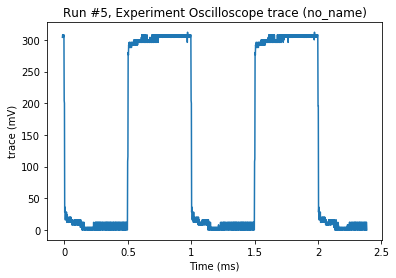This page was generated from
docs/examples/driver_examples/Qcodes example with Rigol DS1074Z.ipynb.
Interactive online version:
.
QCoDeS Example with the Rigol DS 1074 Z oscilloscope¶
This notebook presents the implementation of QCoDeS driver for the Rigol DS1074Z oscilloscope.
Importing dependencies¶
[1]:
# Qcodes import
from qcodes.dataset import (
Measurement,
initialise_database,
load_or_create_experiment,
plot_dataset,
)
from qcodes.instrument_drivers.rigol import RigolDS1074Z
Create the instrument¶
The instrument is created in the following way. The address can be found using the NI-MAX explorer.
[2]:
rigol = RigolDS1074Z("rigol", "USB0::0x1AB1::0x04CE::DS1ZB161650342::INSTR")
Connected to: RIGOL TECHNOLOGIES DS1074Z (serial:DS1ZB161650342, firmware:00.04.00) in 5.44s
Trigger setup¶
Trigger source can be set to any channel (1 to 4). Here we use the input signal from channel 1 itself as a source for trigger.
[3]:
rigol.trigger_edge_source("ch1")
rigol.trigger_edge_slope("negative")
The trigger-mode type supported by this oscilloscope are edge, pulse, video and pattern. Both the trigger mode and trigger level can be set in the following manner.
[4]:
rigol.trigger_mode("edge")
rigol.trigger_level(0.2)
Data acquisition and plotting¶
This particular driver implements acquiring the trace as a ParameterWithSetpoints. Here, we show how the trace can be measured and plotted. For more information on ParameterWithSetpoints refer to this notebook.
[5]:
initialise_database()
exp = load_or_create_experiment(
experiment_name="Oscilloscope trace", sample_name="no_name"
)
[6]:
meas_helper = Measurement(exp=exp)
meas_helper.register_parameter(rigol.channels.ch1.trace)
with meas_helper.run() as datasaver:
datasaver.add_result((rigol.channels.ch1.trace, rigol.channels.ch1.trace()))
Starting experimental run with id: 5
[7]:
_ = plot_dataset(datasaver.dataset)
